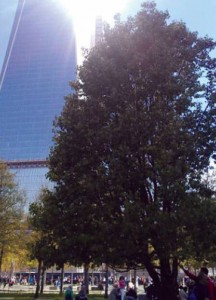By Mubashir Hassan The Nation

The Survivor Tree
NEW YORK – A tree that survived the 9/11 attacks on the twin towers has become a symbol of hope for the Americans who witnessed the traumatic attacks over a decade ago.
It is a Callery pear tree that became known as the ‘Survivor Tree’ after sustaining extensive damage, but living through the deadly attacks.
“All, but one of the trees at the Memorial site in New York are swamp white oaks, taken from the areas surrounding the sites impacted by the massive explosion”, a group of international journalists who visited New York last month were told at the memorial site.
“If the 9/11 memorial has become a symbol of unity for the Americans, this miraculous tree is an emotional metaphor of hope for them”, said Saul Hernandez a senior official of Department of State who led the delegation along with Jackson Farrier Belinda.
The journalists were told that in October 2001, the tree with lifeless limbs, snapped roots and blackened trunk was discovered and freed from the wreckage at the World Trade Center. It was originally planted in the 1970s in the vicinity of buildings 4 and 5 in the WTC complex, near Church Street.
A detailed briefing given on the history of the is miraculous tree revealed that the damaged tree measured 8-feet tall when it arrived in November 2001 at the NYC Parks & Recreation Department’s Arthur Ross Nursery in Van Cortland Park in the Bronx. It was nursed back to health and has since grown to a height of about 30 feet.
Upon the tree’s arrival at the Arthur Ross Nursery, its damaged limbs were pruned, leaving primarily a blackened trunk with a tiny root system to be planted. Year by year, with the tender care and attention of the nursery staff, the tree has grown to greater and greater height, filling in with numerous branches and bountiful leaf cover.
Interestingly, in March 2010, the tree endured another traumatic experience after being uprooted in powerful storms that swept through New York, but ultimately lived up to its name. Caretakers righted the tree, examined its roots, pruned its branches, and secured it with cables. Parks Department staff and 9/11 Memorial staff partnered to ensure the tree’s limbs were properly pruned in preparation for its return to the World Trade Center. Its root ball was also prepared so the tree could be safely moved to its home on the Memorial Plaza. The tree’s vitality is a true testament to its determination to survive, thrive and grow.
The Survivor Tree, which was re-planted at the Memorial in December 2010, continues to grow among some 400 hundred swamp white oak trees that have been planted on the Memorial Plaza after the explosions.
The 9/11 Memorial, opened to public on September, 12, 2011 on the 10th anniversary of terrorist attacks has become the most visited place in lower Manhattan, New York. The visitors have to undergo a rigorous security check before they get to the heavily guarded memorial site. But the number may decrease as the authorities have now decided to charge $25 per visitor.
The memorial consists of two enormous reflecting pools set in the footprints of the Twin Towers. Each pool is about an acre in size; as 30-foot waterfalls cascade down all sides. Two new towers alongside the north and south pools that were built in place of the towers – now represent the Twin Towers.
The names of 2,983 [sic] victims of September 11 attacks at the World Trade Center site, at the Pentagon, and aboard Flight 93, as well as the World Trade Center bombing on February 26, 1993, are inscribed in bronze panels surrounding the pools.

